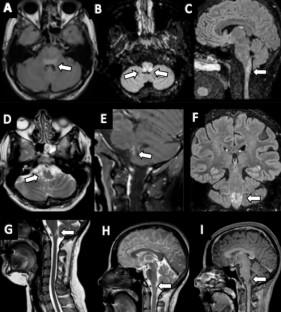Journal of Neurology ( IF 6 ) Pub Date : 2024-04-17 , DOI: 10.1007/s00415-024-12371-8 Claudia Pestchanker , Brenda Bertado Cortez , Marco A. Lana Peixoto , José Ignacio Gortari , Sheila Castro Suarez , Cesar Caparo Zamalloa , Graciana Galiana , Francisco Peñalver , Vanesa Daccach Marques , Katharina Messias , Lorna Galleguillos , Fernando García , Juan I. Rojas , Liliana Patrucco , Edgardo Cristiano , Verónica Tkachuk , Susana Liwacki , Jorge Correale , Mariano Marrodan , María C. Ysraelit , Carlos Vrech , Norma Deri , Felisa Leguizamon , Darío Tavolini , Carolina Mainella , Gisela Zanga , Marina Alonso Serena , Ethel Ciampi , Herval Ribeiro Soares Neto , Pablo Lopez , Edgar Carnero Contentti

|
Introduction
We aimed to assess the frequency, duration, and severity of area postrema syndrome (APS) during follow-up in neuromyelitis optica spectrum disorder (NMOSD) patients, as well as its association with inflammatory activity and prognostic factors of APS severity in a real-world setting.
Methods
We conducted a retrospective study on a cohort of Latin American (LATAM) NMOSD patients who had experienced APS during their follow-up. Patients from Mexico, Peru, Brazil, Colombia, Panama, Chile and Argentina patients who met 2015 NMOSD criteria were included. We evaluated data on symptom type (nausea, vomiting and/or hiccups), frequency, duration, severity (measured by APS severity scale), association with other NMOSD core relapses, and acute treatments (symptomatic and immunotherapy or plasmapheresis). Logistic regression was conducted to evaluate factors associated with APS severity (vs. mild-moderate).
Results
Out of 631 NMOSD patients, 116 (18.3%) developed APS during their follow-up. The most common APS phenotype was severe. Inflammatory activity (i.e., relapses) significantly decreased after the onset of APS. Half of the patients experienced isolated APS with a median duration of 10 days, and the most frequently used acute treatment was IV steroids. All three symptoms were present in 44.6% of the patients. APS symptoms resolved following immunotherapy. Logistic regression did not identify independent factors associated with the severity of APS.
Conclusions
Our findings indicate that 18.3% of NMOSD patients developed APS during the follow-up period, with most patients fulfilling criteria for severe APS. The inflammatory activity decreased after the onset of APS compared to the previous year.
中文翻译:

随访期间后区综合征的发生:现实环境中拉丁美洲的表型及其对 NMOSD 活动的影响
介绍
我们的目的是评估视神经脊髓炎谱系障碍 (NMOSD) 患者随访期间后区综合征 (APS) 的频率、持续时间和严重程度,以及其与炎症活动和 APS 严重程度预后因素的关联。世界设定。
方法
我们对一组在随访期间经历过 APS 的拉丁美洲 (LATAM) NMOSD 患者进行了回顾性研究。来自墨西哥、秘鲁、巴西、哥伦比亚、巴拿马、智利和阿根廷且符合 2015 年 NMOSD 标准的患者均纳入其中。我们评估了症状类型(恶心、呕吐和/或打嗝)、频率、持续时间、严重程度(通过 APS 严重程度量表测量)、与其他 NMOSD 核心复发的关联以及急性治疗(对症治疗和免疫治疗或血浆置换)的数据。进行逻辑回归来评估与 APS 严重程度(相对于轻度至中度)相关的因素。
结果
在 631 名 NMOSD 患者中,116 名 (18.3%) 在随访期间出现了 APS。最常见的 APS 表型是严重的。 APS 发病后炎症活动(即复发)显着降低。一半的患者经历了中位持续时间为 10 天的孤立性 APS,最常用的急性治疗是静脉注射类固醇。 44.6% 的患者同时出现这三种症状。 APS 症状在免疫治疗后得到缓解。 Logistic 回归未发现与 APS 严重程度相关的独立因素。
结论
我们的研究结果表明,18.3% 的 NMOSD 患者在随访期间出现 APS,其中大多数患者符合严重 APS 的标准。 APS发病后炎症活动较前一年有所下降。



























 京公网安备 11010802027423号
京公网安备 11010802027423号